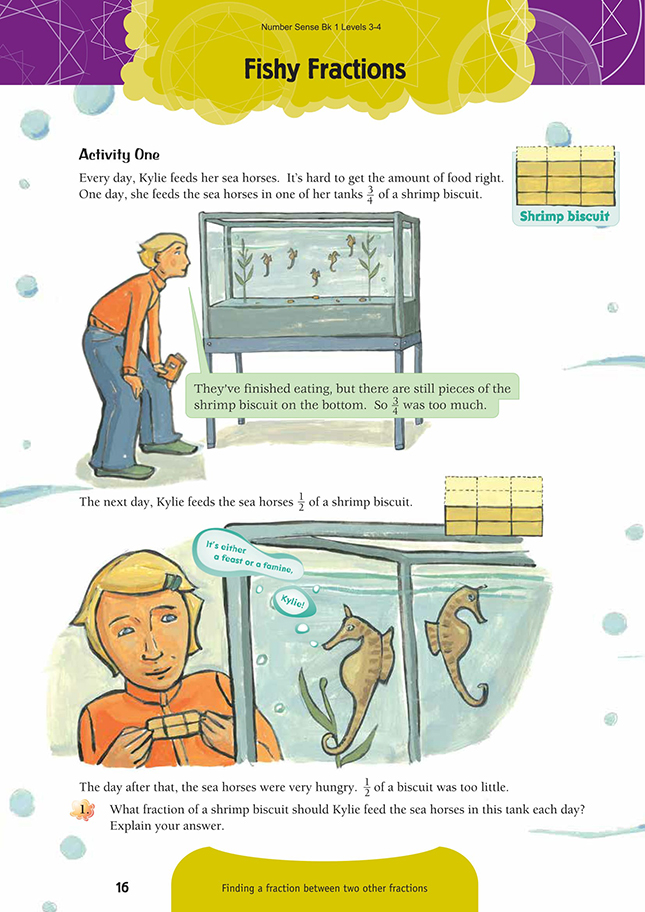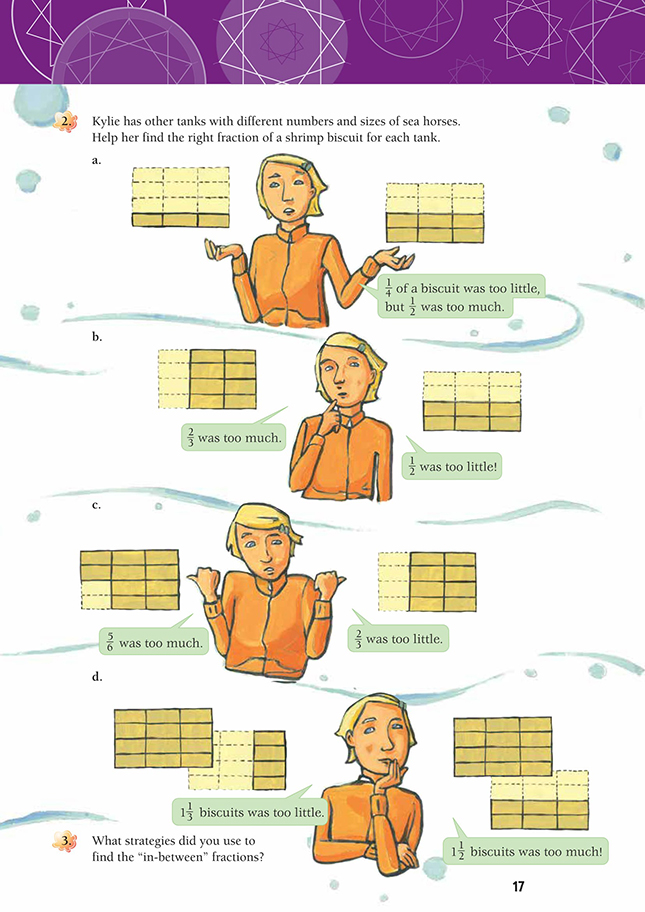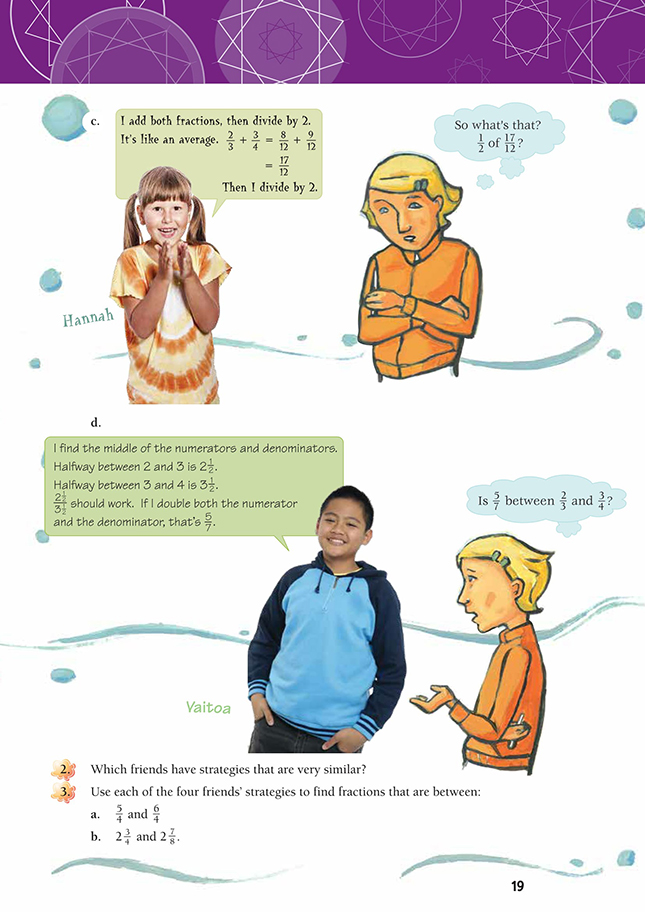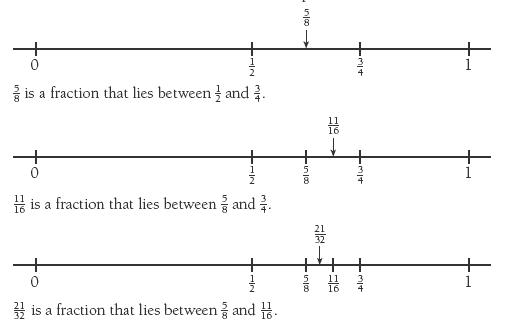This is a level 4 number activity from the Figure It Out series. It relates to Stage 7 of the Number Framework.
A PDF of the student activity is included.
Click on the image to enlarge it. Click again to close. Download PDF (832 KB)
find a fraction between two fractions using equivalent fractions
Number Framework Links
To attempt these activities successfully, students will need to be using multiplicative strategies. Therefore, they will need to be using advanced additive strategies (stage 6) or higher for multiplication and division.
FIO, Levels 3-4, Number Sense and Algebraic Thinking, Book One, Fishy Fractions, pages 16-19
Students often struggle to find a fraction between two fractions if the fractions are close in size but have different denominators. It is an important idea that between any two fractions there is an infinite number of other fractions. For example:
The students need to be able to create equivalent fractions that have different denominators from the original fraction in order to find fractions between two fractions. For example, to find a fraction between 3/4 and 4/5, both fractions could be converted to equivalent fractions with the same denominator.
4 x 5 = 20 is the obvious choice because 3/4 = 15/20 and 4/5 = 16/20.
The students are likely to use the part–whole biscuit diagrams as a guide in finding the fractions in between. For example, to find a fraction between 2/3 and 1/20, the students might notice that one fraction is 8/12 of a biscuit and the other is 6/12. So 7/12 is in between.
On pages 18–19, Charu’s method of finding a fraction between two fractions involves converting both fractions to decimals. This is similar to the equivalent fractions method in that each fraction is converted to a common base. With decimals, the common bases are tenths, hundredths, thousandths, and so on. Fractions can also be converted to percentages, where the common base is hundredths. It is important that students have experience in converting fractions to decimals and percentages and vice versa because this skill is very important in solving more complex operations. Percentages are often used to make comparisons where the bases are different, for
example, comparing basketball shooters who take different numbers of shots.
Both Chris and Hannah use equivalent fractions. In either case, the fractions can be expressed as twelfths. Between 8/12 and 9/12, there exists an infinite number of hypothetical fractions like (8 1/4)/12, (8 1/2)/12 , (8 3/4)/12 , and so on, and these can be converted into equivalent fractions such as 33/48, 17/24, 35/48, and so on.
Hannah’s method also uses averages. Both Hannah and Chris find the midpoints of the numerators, but Hannah does this by adding the fractions and then dividing by 2.
The students can check that Vaitoa’s method works by trying lots of possibilities. The method can also be proved algebraically, but not by students at this level. Vaitoa’s method is based on finding the midpoints (averages) of the numerators and the denominators. To find a fraction between 2/3 and 5/6, he would find the midpoint between 2 and 5 (that is, 3 1/2) and between 3 and 6 (that is, 4 1/2).
The fraction (3 1/2) / (4 1/2) = 7/9 will lie between 2/3 and 5/6.
Question 3 is useful for assessing whether the students are able to apply the strategies to find fractions between fractions. Look for the students to change 2 3/4 and 2 7/8 into improper fractions or to just operate on 3/4 and 7/8, knowing that the fraction between will also be between 2 and 3.
Extension
Connect the concept of “betweenness” of fractions to addition and subtraction problems. For example: “ 1/2 is added to a fraction. The answer is between 2/3 and 3/4. What might the fraction be?” The students should use reverse thinking to realise that the fraction must be between 1/6 and 1/4, and they need to understand that an infinite number of fractions will work. Mathematically, this information can be represented using two inequalities: 1/6 < n < 1/4, where n represents the possible
fraction.
Answers to Activities
Activity One
1. Any fraction between 1/2 and 3/4 is correct, but Kylie is probably looking for a fraction as close to halfway between 1/2 and 3/4 as possible. The shrimp biscuits are divided into twelfths. 1/2 is 6/12, and 3/4 is 9/12, so a “close to halfway” fraction
is 7/12 or 8/12.
2. The fractions given below are close to halfway between the two fractions Kylie has tried in each scenario. They are based on twelfths because that is how the shrimp biscuits are shown on the page. Other fractions close to the halfway point are also acceptable.
a. 1/4 is 3/12, and 1/2 is 6/12, so 4/12 or 5/12should work.
b. 2/3 is 8/12, and 1/2 is 6/12, so 7/12 should work.
c. 5/6 is 10/12 and 2/3 is 8/12, so 9/12 should work. 9/12 is 3/4.
d. 1 1/3 is 1 1/4, and 1 1/2 is 1 6/12 , so 1 5/12 should work.
3. Strategies may vary. First, you have to divide the biscuit into parts so that each fraction can be shown. The strategy used above is to turn the fractions into twelfths and find the halfway point of the numerators (the top numbers). Another strategy is to halve the parts of the shrimp biscuit until you can find an “in-between” fraction.
Activity Two
1. a. The biscuit would need to be divided into tenths, not twelfths.
b. (8 1/2)/12 is the same as 17/24.
c. 1/2 of 17/12 is (8 1/2)/12. (You need to divide the numerator by 2, but the denominator stays the same. (8 1/2)/ 12 is the same as 17/24.
d. Yes, 5/7 is between 2/3 and 3/4 . Using equivalent fractions, 2/3 = 56/84, 5/7 = 60/84, and 3/4 = 63/84. (84 is the lowest common denominator for 3, 7, and 4.) 60 is between 56 and 63.
2. Answers may vary. Chris and Hannah have similar strategies because they both find the value halfway between the two fractions.
3. a.• Decimals method (Charu):
5/4 = 1.25, 6/4 = 1.5. Any fraction that converts to a decimal between 1.25 and
1.5 will do. For example, 1 (1.3333) or 1 4/10 (1.4).
•Halfway method (Chris):
(5 1/2)/ 4, which is 11/8 or 1 3/8
•Averaging method (Hannah):
5/4 + 6/4 = 11/4, 11/4 ÷ 2 = (5 1/2)/4, which is 11/8 or 1 3/8
•Halfway between denominators and numerators method (Vaitoa):
(5 1/2)/4 =11/8 or 1 3/8
2b. • Decimals method (Charu):
2 3/4 = 2.75, 2 7/8 = 2.875. So any decimal between 2.75 and 2.875 will do. For
example, 2.8 = 28/10, which is 14/5 or 2 4/5
•Halfway method (Chris):
2 3/4 = 2 6/8, so 2 (6 1/2)/8 is midway between the two numbers, that is, 2 13/16.
•Averaging method (Hannah):
2 3/4 + 2 7/8 = 2 6/8 + 2 7/8
= 4 13/8
Half of 4 13/8 = 2 wholes and (6 1/2)/8, that is, 2 13/16.
•Halfway between denominators and numerators method (Vaitoa):
2 3/4 = 11/4, 2 7/8 = 23/8. The average (mid value) of 11 and 23 is 17; the average of 4 and 8 is 6. 17/6 = 2 5/6





